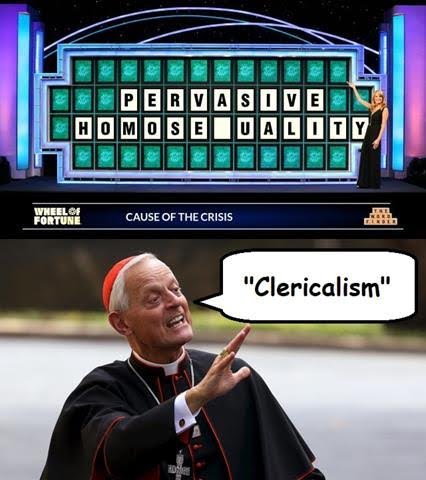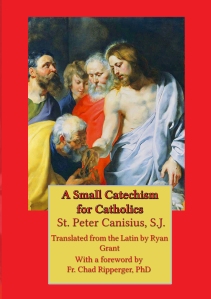 Just today, the Congregation of Divine Worship, at the command of Pope Francis, has decreed that women must be included in the Mandatum, that is the washing of the feet for Holy Thursday, effective this year. Thus, the god of surprises has come to visit us just in time for Septuagesima and the beginning of Lent.
Just today, the Congregation of Divine Worship, at the command of Pope Francis, has decreed that women must be included in the Mandatum, that is the washing of the feet for Holy Thursday, effective this year. Thus, the god of surprises has come to visit us just in time for Septuagesima and the beginning of Lent.
There are lot’s of things to say, but the most important thing is to treat it dispassionately and in union with the Tradition. Pope Francis has said that those who resist change are closed to the working of the spirit, who cling to the way things have always been done are closed to the message of the Gospel. In spite of the twisting of the sense of Scripture in that particular discussion (my basis for which is the original Italian of Francis’ words, not some media report), let’s give him that for the moment. He posits a dichotomy of those who only want to do things the way things were, vs. those who want to apply new things. Thus we don’t receive a teaching and a praxis conditioned by the tradition of signs and symbols that lead us to Christ, to the teaching of the Gospel and the very person of Christ, but rather to the whims of this or that age. What is new and hip and inclusive in our age will be outmoded in the next age.
Moreover, the opposition is not comprised of those who say we must do everything as it has always been done, but that there is a reason why things have been done this way. Thus, the onus is on the Pope to explain why something in the traditional signs and symbols is somehow insufficient to express the reality of the Gospel. The problem is, he prescinds from this, and simply characterizes the opposition as a stick in the mud. It is one thing if he were to show how the traditional signs and symbols were insufficient for some reason, this is possible and the Church is in fact always in need of renewal. But can he show the use of men alone is somehow opposed to the expression of the Gospel?
The practice of washing the feet of men is supposed to express the relationship of Christ with his Apostles, not merely with the Christian community. Still, for all that, there is ample testimony of the Fathers that could be applied also to the community of the faithful, including examples where women’s feet were washed by the Bishop, just not during the Maundy Thursday liturgy. But then again, that might be too much the way things have always been done. The teaching of the Fathers on the question is well summarized by Cornelius á Lapide, in his commentary on the relevant passage of the Gospel (John XIII:6-10), which will suffice for our purposes here: [NB: My translation. There is a very good translation of this available from Loretto, but I do not have it at hand]
“St. Bernard understands in this place as if it were a sacrament, a symbol, a type, a figure, a mystical meaning as he explains a little after, on which we will say more soon.
Symbolicly, Origen and St. Jerome [epist. ad Damasus, de prima visione Isaiae] reckon that Christ washed the feet of the Apostles in order that he might prepare them to preach the Gospel, according to what is said: ‘How beautiful upon the mountains are the feet of him that brings good tidings, and that preaches peace: of him that shows forth good!’ [Isaiah LII:7; Rom. X:15].
Secondly, S. Ambrose, [de iis qui initiantur mysteriis, cap. vi] reckons that Christ in baptism washes away actual sins by washing the head, but here by washing the feet, he washed the remnant of original sin, that is, the motion of concupiscence, for in this washing of the feet, it is effected to have fortified them so that they would resist concupiscence.
Thirdly, St. Augustine and St. Bernard [de Cœna Domini] say: “By such feet we tread over the earth, the love of the earth is signified, filth and defects, which, while on earth, that is while we live among earthly affairs, just as the dust or mud on our feet it behooves us to wash by tears and penance, especially before holy communion.
Fourthly, St. Cyprian [de Cœna Domini] and St. Gregory [lib. ix epist. 39]: “Of the feet, which are the lowest and last part of man, the washing means not only that we must scrutinize our exterior works, but that we must descend even to the lowest and most intimate hidden corners of our conscience, and purge them from every secret stain and wicked intention through contrition, tears and groans.
From this washing of the feet by Christ, the custom of Milan, and several other churches, sprung up that the Bishop would wash those who were going to be baptized, and thereafter the priests and clerics in the font, who stood straight for this purpose outside the Church; thereafter the Bishop kissed the feet of those he washed, and they placed the outer part of the foot over the head of the bishop. St. Ambrose relates and defends this custom [lib. III de Sacram. cap. 1] and says that it was begun by St. Peter and Christ, wherefore he marvels that it is not kept in the Roman Church. Moreover, the Council of Toledo [XVII, cap. iii] ratifies that the Bishops and priests should wash the feet of the faithful at the Lord’s supper after the example of Christ, and commands the use which had ceased for a while to be recalled.
St. Ambrose relates the mystical nature of this washing [lib. De initiandis, cap. VI] saying: “Peter was clean, but ought to wash the sole [of the foot] : for he had the sin of the first man by succession, when the serpent supplanted it and persuaded error; therefore his sole is washed so that hereditary sins would be abolished.” He alludes to those words of God to the serpent concerning man: “Thou shall lie in wait for his heal,” [Genes. III:15]. The same Ambrose [lib. III de Sacram., cap. 1] says: “Because Adam was supplanted by the devil, and the poison flowing into him and over his feet, therefore you wash the feet so that in that part, in which the serpent lies in wait, shall come upon a greater sanctification, in which afterward he cannot supplant you. Therefore you wash the feet, so that you wash the poison of the serpent. Moreover, it will effect humility, so that you will not blush in the mystery, that we will not disdain obedience.”
Another reason was more literal, because formerly those to be baptized approached with naked feet, that they would conduct themselves with humility. For that reason, this nakedness of the feet is called humility by St. Augustine [lib. de Symbolo ad Catech., cap. 1]; because they will wash the filth that has been contracted on the feet. This custom began to spread from the Church of Milan to others, as is clear from St. Augustine.”
Now, we could go on at length with many more testimonies to the same thing. What we can see is that the objections of some, that the priest will kiss a woman’s foot at the mandatum, was not a problem for St. Ambrose and the fathers of other churches where this custom spread to. Then again, the culture was not as over-sexualized as it is today where you have foot fetishes and other things of immoderate men. I don’t know if such a thought would occur to most priests, but it may to some laity. So if Francis wanted to overturn the custom prevailing in all Churches of only washing men’s feet, he could appeal to this example in the Fathers, that such washings were done from the Lord’s example for the community (men and women) who were to be baptized, and then he might have some ground to stand on in terms of uniting this symbol at the liturgy with the example of antiquity. But then his notion of mercy, trumpeted so much at the last synod in regard to public adulterers, could be exposed to attack by the same example. Again from á Lapide, on John XIII:10:
“Mark, here Christ alludes to those who wash themselves in a bath, who go out from it with their whole body being cleansed, but because they tread upon the earth with their naked feet, therefore they might say the feet, for that reason alone are washed afterward. Mark secondly, Christ speaks anagogically [that is, in regard to man’s final state] that by his custom they rise from corporal washing to a spiritual one, in other words, one who is washed is done so spiritually through baptism, in which I have washed you, O Apostles, or one who is washed through contrition and penance, here is wholly clean in soul, but still needs that he wash only his feet, that is the affects of the soul, again by reason of earthly things, in which they live, are stained by contagion and contract light filth that they must often purge through contrition, castigation of the body and like virtues (of which this my washing is a symbol), and especially before the Sacred Liturgy and reception of the Eucharist. Thus St. Augustine, Bede, and especially St. Bernard [serm. In Cœna Domini] say: “He who is washed, needs nothing but that he should wash the feet. He is washed, who does not have grave sins, whose head, that is intention, and hand, that is the operation and good life, is clean; but the feet, which are the affections of the soul, while we step in this dust, from the whole cannot be of the world, which at some time tread in vanity, lust or curiosity, it rather more behooves the soul that it should fall even now. For we all offend in many things. But no man scorns or slights. For it is impossible to be saved by those, it is impossible that I have washed except through Christ Jesus, and by Christ.”
Whereas, directly contradicting what Christ said, that he who divorces his wife and marries another (Matt. XIX) commits adultery, can that be said to be a light matter? Not a grave sin?
Nevertheless, picking up in the next paragraph with Lapide, we see the relationship of Christ with the Apostles:
“Therefore, Christ, in this washing of the feet of Peter and the Apostles cleanses sins, especially venial ones, because through that and only through His forgiveness does he goad their minds, and admonished them by making internal washing through contrition in their souls, through which venial sins are expiated.
For this reason, priests in the OT washed their feet and hands before the sacrifice, as I have already said. Likewise, many heathen did the same thing, as Brissonius recalls [lib. I De Formulis Roman., pag. 4]. Formerly the Jews did the same thing, as is clear from Mark VII:4, and they still do the same thing today.
Next, St. Augustine [epist. 108 ad Seleucianum] from “qui lotus est“, probably gathers that Peter and the Apostles were baptized before the Eucharist, then because no man has the capacity for the Eucharist unless he has been baptized, for after His death he baptized no man, it is certain that they were all either immediately or mediately baptized by Christ. Then, the “washing” would probably have been the washing done in baptism.”
Thus, the relationship expressed in the washing of the feet of the Apostles by Christ, is not just of a hierarchical relationship, though that is properly one aspect, but one of the intimate communion that his Apostles, as priests conformed to Christ’s very person, share with him in spite of their human nature. They are washed as preparation for becoming priests of the new and eternal covenant, of which baptism is necessary, that is being put to death to the world, and born anew in Christ Jesus. The mandatum, as preserved and passed down in the sacred liturgy of Maundy Thursday, is intended to preserve this identification of Bishops and Priests as other Christs, being cleansed from sin and made unto him, whereas the early Church (as seen in St. Ambrose, St. Augustine and the Bishops of other Churches, as Lapide mentions) also sought to incorporate the symbol of the Bishop conformed to Christ, the suffering servant who is nonetheless God, in the rite of baptism.
As a side note, Catholics should take note that the practice of blessing themselves with Holy Water when they come into Church derives from this ancient practice, which is why the modern practice in many modern churches of removing the holy water during Lent an replacing it with sand is all the more inexplicable.
Now, as I noted, Pope Francis could overturn this particular tradition in the mandatum under the desire to emulate the Baptism of the faithful, but if that were the case he should give very clear reasons as to why the old symbol were inefficient to this, or why the expression of the priesthood as perfectly conformed to Christ as servants no longer satisfies and should be expressive of who we are today. In fact, the very purpose of liturgical symbols is to remind men of changing fashions what the symbols represent and call them back to the gospel—both clergy and laity—not to correspond to changing fashions. What Pope Francis has done, is to destroy a symbol without any particular reasoning or purpose apart from what seems inclusive for today. And therein lies the very problem. A protestant friend of mine very aptly encapsulated the faulty reasoning of this initiative in the following satire:
“I hereby propose that a reasonably accurate modern equivalent of Jesus washing the disciples’ feet would be Jesus doing their dishes. Harder to fit into the Maundy Thursday service, though.”
Could it be that Pope Francis is the one doing things the way they have always been done—since 1965?
 Today we are rejoined by Fr. Chad Ripperger, PhD, to talk about the abuse crisis in the Church in light of the revelations concerning former Cardinal Theodore McCarrick, the mass cover-ups carried out by bishops in Pennsylvania as revealed by the PA Grand Jury report, and the allegations against the Pope made by Archbishop Viganó. Instead of rehashing what has made the rounds on news, blogs and op-ed pieces, Fr. Ripperger discusses past Church legislation governing seminarians and clergy, and how the Vatican directed seminaries to deal with the problem of corrupt seminarians before Vatican II. He addresses the problem of homosexuality and the wider problem of a failure to keep chastity among seminarians, priests and bishops. Lastly, Father deals with the argument that everything is to blame on “clericalism” and shows that this is a veiled attack on the Catholic priesthood, and what the theology of the priesthood actually is. Not to be missed.
Today we are rejoined by Fr. Chad Ripperger, PhD, to talk about the abuse crisis in the Church in light of the revelations concerning former Cardinal Theodore McCarrick, the mass cover-ups carried out by bishops in Pennsylvania as revealed by the PA Grand Jury report, and the allegations against the Pope made by Archbishop Viganó. Instead of rehashing what has made the rounds on news, blogs and op-ed pieces, Fr. Ripperger discusses past Church legislation governing seminarians and clergy, and how the Vatican directed seminaries to deal with the problem of corrupt seminarians before Vatican II. He addresses the problem of homosexuality and the wider problem of a failure to keep chastity among seminarians, priests and bishops. Lastly, Father deals with the argument that everything is to blame on “clericalism” and shows that this is a veiled attack on the Catholic priesthood, and what the theology of the priesthood actually is. Not to be missed.
 Just today, the Congregation of Divine Worship, at the command of Pope Francis, has decreed that women must be included in the Mandatum, that is the washing of the feet for Holy Thursday, effective this year. Thus, the god of surprises has come to visit us just in time for Septuagesima and the beginning of Lent.
Just today, the Congregation of Divine Worship, at the command of Pope Francis, has decreed that women must be included in the Mandatum, that is the washing of the feet for Holy Thursday, effective this year. Thus, the god of surprises has come to visit us just in time for Septuagesima and the beginning of Lent.




 A breaking news item, at the minute of this posting, is the resignation of Bishop Finn from the Diocese of Kansas City – St. Joseph. According to a news report:
A breaking news item, at the minute of this posting, is the resignation of Bishop Finn from the Diocese of Kansas City – St. Joseph. According to a news report:



